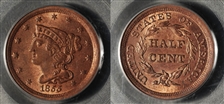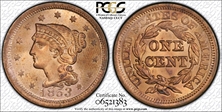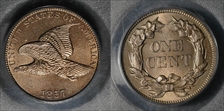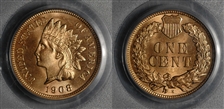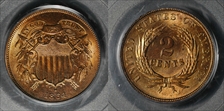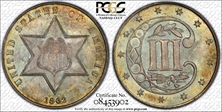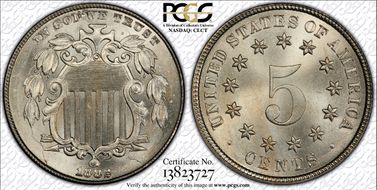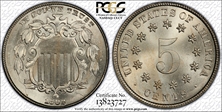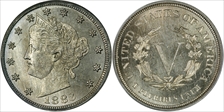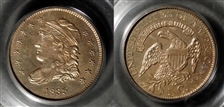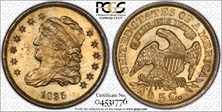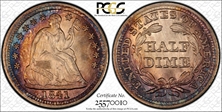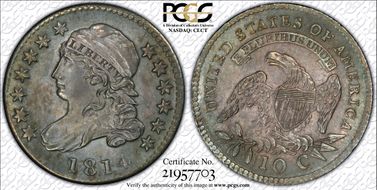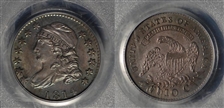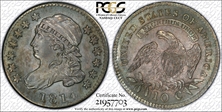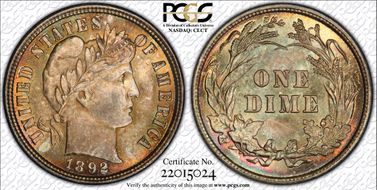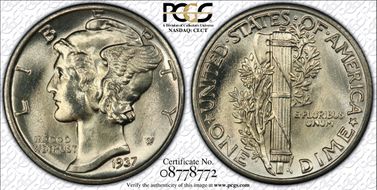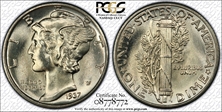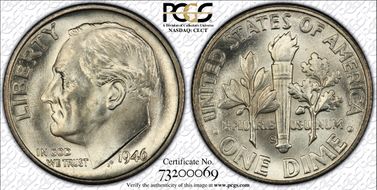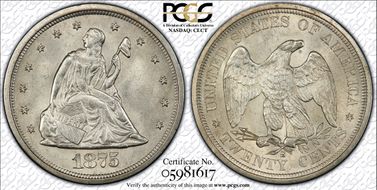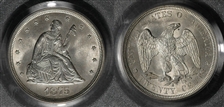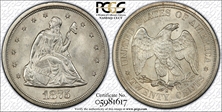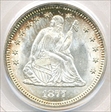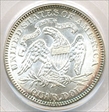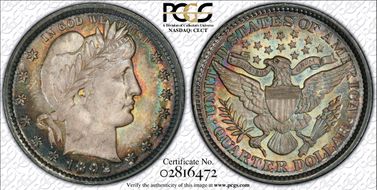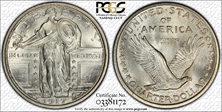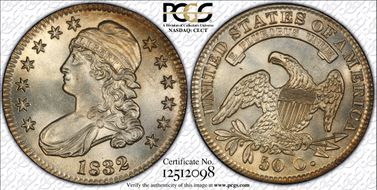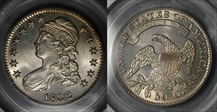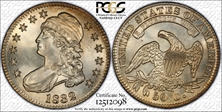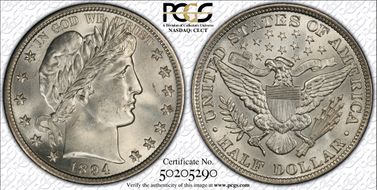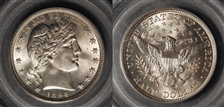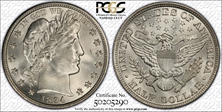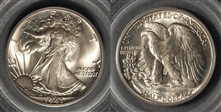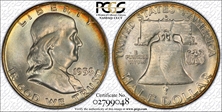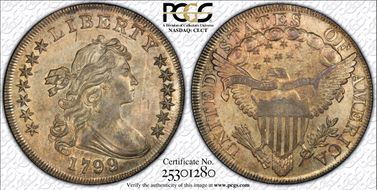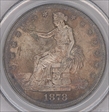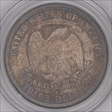Gobrecht's Raisinet Collection 的钱币相册
A gorgeous fire-red near Gem type coin that has nearly mark-free surfaces. The devices are very well struck, although portions of the dentils are softly brought up. Carbon is microscopic.
1853 MS65RD. So firey red the coin almost looks like it was minted yesterday, with virtually no marks and only a slight partial fingerprint to justify this grade, as opposed to a higher one.
1853 MS65RD. So firey red the coin almost looks like it was minted yesterday, with virtually no marks and only a slight partial fingerprint to justify this grade, as opposed to a higher one.
1853 MS65RD. So firey red the coin almost looks like it was minted yesterday, with virtually no marks and only a slight partial fingerprint to justify this grade, as opposed to a higher one.
1857 Flying Eagle Cent, graded MS-65. Simply outstanding! This coin has a full strike and breathtaking eye appeal. It is a gem in every respect. The color is an even light nickel color with just a light contact marks above the Eagle's left wing. The reverse is nearly mark free. A superb coin. Pop 166; 15 finer in 66. Ex:The "Chiro" Collection. Eagle Eye Photo Seal.
1908-S 1C MS66RD. This is an outstanding, intensely bright example of the first minor (copper) coinage issue struck at a branch mint in the United States. Judging from the population data, the 1908-S and 1909-S Indian cents are about equal in rarity in high grades with full red color, and both are much, much rarer than the 1909-S VDB cent in such condition. Although the 1908-S was probably saved to some degree as the first mintmarked cent, the 1909-S Indian was saved as the last of the series (and the general collecting public saved many more 'SVDBs as a novel new design). The San Francisco cents of 1908 and 1909 were struck on lighter-colored planchets than earlier cent issues. The '08-S is a scarce (1.1 million pieces produced), semi-key issue in the Indian Head cent series at all levels of preservation. Obviously set aside shortly after delivery, this fully Red, carbon-free example of this introductory, branch-mint Indian cent displays unbelievable flash. The coin possesses full mint luster and even, orange-red coloration. Copper-gold luster adorns both sides, and the well-executed, virtually full strike is exacting throughout, resulting in crisp definition of the design features, including sharpness on the bowknot, all four diamonds, and on the tips of the feathers at the top of the Indian's headdress. Both sides are exceptionally smooth with a shimmering satin texture. Close examination reveals remarkably clean surfaces and no spots worthy of note; There are only a couple of slight, relatively unobtrusive contact marks on the cheek and neck to justify this grade, as opposed to a higher one. A magnificent example of this scarce, late-date Indian cent, this piece shows even, bright mint red color, unlike the streaky coins often seen on 1908 and especially 1909 cents. Rick Snow states "Full feathers are extremely rare" [on an '08-S] but if the strike atop the headdress feathers of this coin is not fully razor-sharp, in light of the issue's striking weakness being ever-present, this is forgivable. The Eliasberg catalog notes that 1908-S cents were struck on silver presses. The hardness of bronze compared to silver might help explain why this issue is usually found softly struck. That being said, Mr. Eliasberg held out for a sharp one, and I've been fortunate, too. The srike on this piece is exemplary. It would be difficult to imagine a more attractive example.
1864 2C Large Motto MS65RD. A fiery, very premium quality Gem of this important and widely collected odd denomination. Millions were struck of this first year issue, but full red Gems are anything but common. The surfaces of this coin display a vibrant and totally original orange-red color that barely shows just a whisper mellowing in the nearly 15 decades since its Civil War era origin. The mint red color is virtually undiminished by the passage of time, appearing today much as it did in 1864, the year Colonel Chivington massacred the Southern Cheyenne at Sand Creek. This unusual denomination was created to help fill the yawning gap in circulating coinage that resulted from the widespread hoarding of coins in the early 1860s. An historic issue designed by James Barton Longacre that is indelibly linked with the Civil War, the 1864 two cent piece is also the first U.S. coin to bear the motto IN GOD WE TRUST. The present example is the second and more commorn of the two varieties produced this year. The earlier Small Motto coins were prototypes and modified after only a few thousand were struck, with the motto enlarged on subsequent strikings. Far fewer of the Small Motto coins are seen today with full red color than of their Large Motto counterparts. Held back from an even higher grade only by light, scattered flyspecks, and uncommonly attractive even for the MS65 grade, this Large Motto Gem shows nearly full mint-red color. Both sides are intensely lustrous, with vivid crimson-orange color. All features show pinpoint striking definition, with with good detail to the highpoints. The lustrous and unabraded surfaces have no obtrusive contact marks, and only negligible carbon.
1868 3CN MS66. Well struck and untoned, with lustrous pearl-gray surfaces that are essentially unmarked on both sides. A splendid Premium Gem example of this conditionally scarce issue. Population: 25 in 66, 1 finer (2/07).(
1862/1 3CS MS66. The left half of the 2 in the date has a faint but nearly complete 1. The underdigit is faint but clearly discernible with a magnifier. Bold die clash marks are evident on this scarce overdate variety, especially on most of the obverse shield within the III. Very sharply struck for a Type Three, this piece shows exceptionally pronounced evidence of die clashing, and that is saying a lot for a three cent silver as they are usually die clashed.
1862/1 3CS MS66. The left half of the 2 in the date has a faint but nearly complete 1. The underdigit is faint but clearly discernible with a magnifier. Bold die clash marks are evident on this scarce overdate variety, especially on most of the obverse shield within the III. Very sharply struck for a Type Three, this piece shows exceptionally pronounced evidence of die clashing, and that is saying a lot for a three cent silver as they are usually die clashed.
1862/1 3CS MS66. The left half of the 2 in the date has a faint but nearly complete 1. The underdigit is faint but clearly discernible with a magnifier. Bold die clash marks are evident on this scarce overdate variety, especially on most of the obverse shield within the III. Very sharply struck for a Type Three, this piece shows exceptionally pronounced evidence of die clashing, and that is saying a lot for a three cent silver as they are usually die clashed.
1882 5C MS66. Blazing luster is the hallmark of this exceptional, untoned Premium Gem. Spindly die cracks are noticeable on the obverse, as usual. A planchet flaw is observed on the upper obverse border, between D and W. Surface blemishes are nearly nonexistent. Population: 68 in 66, 4 finer (7/07).
1882 5C MS66. Blazing luster is the hallmark of this exceptional, untoned Premium Gem. Spindly die cracks are noticeable on the obverse, as usual. A planchet flaw is observed on the upper obverse border, between D and W. Surface blemishes are nearly nonexistent. Population: 68 in 66, 4 finer (7/07).
1883 No Cents MS66. Undoubtedly one of the most common type coins in all of U. S. numismatics, the 1883 No Cents nickel is easily located in all uncirculated grades, up to and including MS66. While it may be accurate to call the No Cents nickel a "common" coin, it is not often available and considering its status as a one-year type, it certainly is not overpriced in grades above MS65.
1913 5C Type 1, MS67. The 1913 Type One Buffalo nickel is always in great demand as a first-year-of-issue date and a one-year type coin. David Lange (2000) writes that: "The changeover to the Type 2 reverse was ordered on May 6, [1913] and coinage of the revised nickels commenced four days later." The present coin is a high-end example of this popular one-year type, strongly lustrous beneath pleasing gold and iridescent toning. Sharply struck and showing the rugged detail that makes the variety so prized, even LIBERTY and the obverse rim portray relatively nice detail, these features usually showing weakness on this issue. Each side has a pronounced matte-like texture, typical of all Type One nickels (David Lange, The Complete Guide to Buffalo Nickels). Noted sculptor James E. Fraser designed the Buffalo nickel. The first type, issued only in 1913, featured a textured field and a raised mound beneath the bison. Since the mound allowed the denomination to wear, it was recessed for the Type Two design, issued later in 1913. But the Mint neglected to recess the Indian's shoulder, where the date is, and well-circulated examples of either type are often dateless. This piece displays powder blue and light gold toning over vibrant luster, which combines with the finely granular surfaces to give each side a shimmering quality. The fields of all Type One Buffalo nickels, not just the proof coins, show the textured fields as on James Earle Fraser's original models, and therefore they give the coins' luster a "shimmering quality, particularly on unworn dies," according to Lange. In fact, "first strikes from unworn dies are easily mistaken for proofs and vice versa."
1835 H10C Small Date, Large 5C MS65. V-5, LM-8.2, R.2. Sun-gold toning is predominant, and the strike is excellent. The 1 in the date is high, and the tip of the feather is right of center of the 5 in the denomination. This late die state of this die marriage is more plentiful than the early die state.
1835 H10C Small Date, Large 5C MS65. V-5, LM-8.2, R.2. Sun-gold toning is predominant, and the strike is excellent. The 1 in the date is high, and the tip of the feather is right of center of the 5 in the denomination. This late die state of this die marriage is more plentiful than the early die state.
1835 H10C Small Date, Large 5C MS65. V-5, LM-8.2, R.2. Sun-gold toning is predominant, and the strike is excellent. The 1 in the date is high, and the tip of the feather is right of center of the 5 in the denomination. This late die state of this die marriage is more plentiful than the early die state.
1841 H10C MS67 V-2 Mintage: 50,000. The last 1 in the date is low and recut, and a small lunule appears between stars 10 and 11. Sharply struck, this is an extraordinarily well-preserved Superb Gem of this type, with full original luster and an exemplary strike, struck from moderately clashed dies. The surfaces emit a warm glow, with lightly toned, golden-rose centers and rich golden-brown, mauve and cobalt-blue peripheral colors about the rims. This second year of the Drapery sub-type is more available than its introductory 1840 counterpart, but relatively few pieces have been certified by PCGS in Mint State grades. Among half dime collectors the 1841 is considered a common date, but it certainly is uncommon in MS67 condition. VARIETIES: V-1 (Proof only). V-2 and V-3 represent variations of the date replacement. There is also a repunched date (RPD) variety with a repunched 1 at the top, and a reverse with heavy lettering designated V-4. The V-2 in late die states exhibits a significant die crack running diagonally from 2 to 7 o’clock. Evidencing not a hint of a crack, this piece would seem to be an example of a much earlier die state. The V-2 variety usually is strongly struck, other than minor weakness of dentils on the reverse, with a full head, shield and toe. The date and stars are boldly punched. The pendant lines up just right of the upright of the 4, and the shield points to the top of the 1.
1841 H10C MS67 V-2 Mintage: 50,000. The last 1 in the date is low and recut, and a small lunule appears between stars 10 and 11. Sharply struck, this is an extraordinarily well-preserved Superb Gem of this type, with full original luster and an exemplary strike, struck from moderately clashed dies. The surfaces emit a warm glow, with lightly toned, golden-rose centers and rich golden-brown, mauve and cobalt-blue peripheral colors about the rims. This second year of the Drapery sub-type is more available than its introductory 1840 counterpart, but relatively few pieces have been certified by PCGS in Mint State grades. Among half dime collectors the 1841 is considered a common date, but it certainly is uncommon in MS67 condition. VARIETIES: V-1 (Proof only). V-2 and V-3 represent variations of the date replacement. There is also a repunched date (RPD) variety with a repunched 1 at the top, and a reverse with heavy lettering designated V-4. The V-2 in late die states exhibits a significant die crack running diagonally from 2 to 7 o’clock. Evidencing not a hint of a crack, this piece would seem to be an example of a much earlier die state. The V-2 variety usually is strongly struck, other than minor weakness of dentils on the reverse, with a full head, shield and toe. The date and stars are boldly punched. The pendant lines up just right of the upright of the 4, and the shield points to the top of the 1.
1814 10C Large Date MS64. JR-3, R.2. The obverse has normal stars without repunching on stars 3, 4, and 5. This die variety is distinguishable by the low curl extending to the right edge of the second 1 in the date, and the lack of the period after the C of 10 C. Somewhat bluntly struck on the hair curls and stars to the right as usual; additional weakness appears on the stars to the left and on the eagle's claws. The dark surfaces are still lustrous, but beneath deep lilac and iridescent green toning. A relatively common variety with a number of Choice or Gem Mint State pieces known, and ideal for the type collector.
1814 10C Large Date MS64. JR-3, R.2. The obverse has normal stars without repunching on stars 3, 4, and 5. This die variety is distinguishable by the low curl extending to the right edge of the second 1 in the date, and the lack of the period after the C of 10 C. Somewhat bluntly struck on the hair curls and stars to the right as usual; additional weakness appears on the stars to the left and on the eagle's claws. The dark surfaces are still lustrous, but beneath deep lilac and iridescent green toning. A relatively common variety with a number of Choice or Gem Mint State pieces known, and ideal for the type collector.
1814 10C Large Date MS64. JR-3, R.2. The obverse has normal stars without repunching on stars 3, 4, and 5. This die variety is distinguishable by the low curl extending to the right edge of the second 1 in the date, and the lack of the period after the C of 10 C. Somewhat bluntly struck on the hair curls and stars to the right as usual; additional weakness appears on the stars to the left and on the eagle's claws. The dark surfaces are still lustrous, but beneath deep lilac and iridescent green toning. A relatively common variety with a number of Choice or Gem Mint State pieces known, and ideal for the type collector.
1887 10C MS66. Cobalt-blue, gray, and lavender toning dances over lustrous surfaces. Well struck, except for the hair on Liberty's head and the bow knot. No major blemishes are apparent.
1887 10C MS66. Cobalt-blue, gray, and lavender toning dances over lustrous surfaces. Well struck, except for the hair on Liberty's head and the bow knot. No major blemishes are apparent.
An impressive Premium Gem, this lovely first-year Barber dime has bold and complete design elements. It is an original coin that is toned in deep iridescent shadings, well balanced on each side, with excellent underlying mint luster.
An impressive Premium Gem, this lovely first-year Barber dime has bold and complete design elements. It is an original coin that is toned in deep iridescent shadings, well balanced on each side, with excellent underlying mint luster.
1937 10C MS67FB. Adolph A. Weinman's Winged Liberty head or "Mercury" design made its debut as part of the coinage revolution that swept the dime, quarter, and half dollar in 1916. This classic design was used on the dime, and the obverse depicted a portrait of Liberty modeled after Elsie Stevens. Liberty wears a winged cap which symbolizes freedom of thought, but she was soon confused with the Roman god Mercury, and the name has been with her ever since. A fasces with an olive sprig dominates the reverse. Production quality was consistently excellent on this 1937 issue of more than 56 million pieces, so it is not surprising that many Superb Full Bands examples survive today. But even for an issue that is known for high quality survivors, this Superb Gem is as well preserved as one would expect from the grade, offering thick mint frost in generous proportions on each side, along with a bold strike and a near-total lack of contact evidence. Glowing luster radiates from the near-pristine, snow-white surfaces. The dazzling, untoned surfaces are strongly detailed and look almost as they did when made. Sharply struck, the all-important central bands are well defined. The only contact mark is a tiny nick in the field on the reverse, above and to the right of the O in ONE.
1937 10C MS67FB. Adolph A. Weinman's Winged Liberty head or "Mercury" design made its debut as part of the coinage revolution that swept the dime, quarter, and half dollar in 1916. This classic design was used on the dime, and the obverse depicted a portrait of Liberty modeled after Elsie Stevens. Liberty wears a winged cap which symbolizes freedom of thought, but she was soon confused with the Roman god Mercury, and the name has been with her ever since. A fasces with an olive sprig dominates the reverse. Production quality was consistently excellent on this 1937 issue of more than 56 million pieces, so it is not surprising that many Superb Full Bands examples survive today. But even for an issue that is known for high quality survivors, this Superb Gem is as well preserved as one would expect from the grade, offering thick mint frost in generous proportions on each side, along with a bold strike and a near-total lack of contact evidence. Glowing luster radiates from the near-pristine, snow-white surfaces. The dazzling, untoned surfaces are strongly detailed and look almost as they did when made. Sharply struck, the all-important central bands are well defined. The only contact mark is a tiny nick in the field on the reverse, above and to the right of the O in ONE.
1946-S 10C MS67. A highly lustrous example from the first year of issue, precisely struck and highly attractive. Roosevelt dime collectors know that the early S-mint dates are the most desirable issues in the series.
1946-S 10C MS67. A highly lustrous example from the first year of issue, precisely struck and highly attractive. Roosevelt dime collectors know that the early S-mint dates are the most desirable issues in the series.
1831 25C Small Letters MS64. B-4, R.1. Minage: 398,000. No quarters were struck in 1829 or 1830, and when the denomination resumed production in 1831, the diameter was reduced from 27 mm to 24.3 mm. The weight and alloy were unchanged, which implies that the new quarters were thicker. Half eagles also were reduced in diameter, beginning in 1829, but otherwise retained prior alloy and weight standards. These changes in diameter were made to conform to the new close collar technology introduced to the Philadelphia Mint. However, Capped Bust halves, which then dominated silver coin production, continued to be struck with lettered edges until the 1836 Reeded Edge halves were produced. This is a lustrous and brilliant silver-white example of the Capped Bust quarter dollar design. Star 7 points to lower curl, the lower right star is close to the hair, square based 2 in the denomination, eagle has long tongue, 25 C closer to eagle than dentils, 25 is high and the arrow heads are thin. There are remnants of die rust above and left of the final S in STATES. This is a later die state of the B-4 variety with a fine die crack through the C of the denomination to the stem above, and another connecting the lower left base of the A in AMERICA with the middle serif of F in OF. Repunching shows on the 5 of the denomination. This is Die State III in Walter Breen's revision of the Browning reference, apparently the most common die state of this variety. Only the barest glimpse of a golden patina accompanies this needle-sharp near-Gem. The strike is exquisite and a strong lens reveals only trivial contact. A wonderful type coin from the Age of Jackson from The Lanterman's Mill Collection.
1831 25C Small Letters MS64. B-4, R.1. Minage: 398,000. No quarters were struck in 1829 or 1830, and when the denomination resumed production in 1831, the diameter was reduced from 27 mm to 24.3 mm. The weight and alloy were unchanged, which implies that the new quarters were thicker. Half eagles also were reduced in diameter, beginning in 1829, but otherwise retained prior alloy and weight standards. These changes in diameter were made to conform to the new close collar technology introduced to the Philadelphia Mint. However, Capped Bust halves, which then dominated silver coin production, continued to be struck with lettered edges until the 1836 Reeded Edge halves were produced. This is a lustrous and brilliant silver-white example of the Capped Bust quarter dollar design. Star 7 points to lower curl, the lower right star is close to the hair, square based 2 in the denomination, eagle has long tongue, 25 C closer to eagle than dentils, 25 is high and the arrow heads are thin. There are remnants of die rust above and left of the final S in STATES. This is a later die state of the B-4 variety with a fine die crack through the C of the denomination to the stem above, and another connecting the lower left base of the A in AMERICA with the middle serif of F in OF. Repunching shows on the 5 of the denomination. This is Die State III in Walter Breen's revision of the Browning reference, apparently the most common die state of this variety. Only the barest glimpse of a golden patina accompanies this needle-sharp near-Gem. The strike is exquisite and a strong lens reveals only trivial contact. A wonderful type coin from the Age of Jackson from The Lanterman's Mill Collection.
1877 25C MS66. Type Two Reverse. The 1877 Seated Liberty quarter is more difficult to locate than the mintage of nearly 11 million pieces would suggest. Many examples were melted in 1878 to provide silver bullion for Morgan dollars. The present coin is a well-struck Premium Gem, with lustrous surfaces and gold and violet highlights. The reverse displays extensive die cracks and clash marks.
1877 25C MS66. Type Two Reverse. The 1877 Seated Liberty quarter is more difficult to locate than the mintage of nearly 11 million pieces would suggest. Many examples were melted in 1878 to provide silver bullion for Morgan dollars. The present coin is a well-struck Premium Gem, with lustrous surfaces and gold and violet highlights. The reverse displays extensive die cracks and clash marks.
1892 25C MS66. Mintage: 8,237,245. An impressive Gem with warm golden gray centers that give way to intense gold, violet, crimson, carmine, and other vibrant hues too numerous to mention. Sharply struck from a Type II reverse die with the eagle's right wing covering all but the serif of the E in UNITED. The difference between Type I and Type II quarters can be easily remembered by the mnemonic device "Now you see it, now you don't." On Type Ones, the middle serif of the E in UNITED is about halfway visible, while on Type Two quarters, the eagle's wing covers it.
1892 25C MS66. Mintage: 8,237,245. An impressive Gem with warm golden gray centers that give way to intense gold, violet, crimson, carmine, and other vibrant hues too numerous to mention. Sharply struck from a Type II reverse die with the eagle's right wing covering all but the serif of the E in UNITED. The difference between Type I and Type II quarters can be easily remembered by the mnemonic device "Now you see it, now you don't." On Type Ones, the middle serif of the E in UNITED is about halfway visible, while on Type Two quarters, the eagle's wing covers it.
1917-D 25C Type 1 MS66 Full Head, Mintage: 1,509,200. Hermon Atkins MacNeil's Standing Liberty is one of the most beautiful designs ever to grace a U.S. quarter. The issues of 1916 and the first half of 1917 display Liberty with an exposed breast. For years, collectors have accepted Breen's story that the Society for the Suppression of Vice forced the modification of the original Standing Liberty quarter design on grounds of obscenity. While the society certainly voiced its opinion and exercised its political muscle, Treasury Secretary William G. McAdoo was the real driving force behind the introduction of the Type Two design in 1917. Fearing public criticism, McAdoo ordered the design change to preserve his own political ambitions. His presidential aspirations were, however, dashed in the elections of 1918 and 1924. The present coin is a brilliant, frosty example of one of the beautiful, underrated and short-lived Type-One-mintmarked Standing Liberty quarters. The D-mint 1917 Type One quarter sells for approximately twice as much as its P-mint counterpart, yet it is three to five times scarcer. The 1917-D Type One is not a rare coin in an absolute sense but, being a branch mint issue, is it not surprising that examples are a bit more elusive than those of the 1917 Type One production. This disparity widens as one progresses up the grading scale. Although not as common as its P-mint counterpart, the 1917-D Type One is still a popular issue for Gem quality type purposes. Once the early troubles were worked out with the modest number of pieces struck in 1916, the Type One design yielded consistently excellent strikes. As with many high grade survivors, pinpoint detailing embodies all the design elements of the present example of this first-year Denver issue. This is an uncommonly well-defined coin for the series, going beyond full definition of Liberty's head and gown lines. Fully struck on all the design features, the detail is superb not only of Liberty's head and gown, but there is also unusually sharp definition of the small feathers on the eagle's breast, and on the ear, neck, and throat of Liberty. There is a sharp line separating the hair, and the horizontal and vertical shield lines are fully brought up as well. Extremely appealing with intense mint luster and no mentionable distractions of any sort, the silver-white untoned surfaces display a characteristic matte-like texture, although with greater radiance than is normally seen. This is a truly amazing Standing Liberty quarter regardless of date. The striking details are especially notable and brilliant throughout, the surfaces exude a thick mint frost that rolls around each side unimpeded by the post-striking defects one would expect on a lower graded coin.
1917-D 25C Type 1 MS66 Full Head, Mintage: 1,509,200. Hermon Atkins MacNeil's Standing Liberty is one of the most beautiful designs ever to grace a U.S. quarter. The issues of 1916 and the first half of 1917 display Liberty with an exposed breast. For years, collectors have accepted Breen's story that the Society for the Suppression of Vice forced the modification of the original Standing Liberty quarter design on grounds of obscenity. While the society certainly voiced its opinion and exercised its political muscle, Treasury Secretary William G. McAdoo was the real driving force behind the introduction of the Type Two design in 1917. Fearing public criticism, McAdoo ordered the design change to preserve his own political ambitions. His presidential aspirations were, however, dashed in the elections of 1918 and 1924. The present coin is a brilliant, frosty example of one of the beautiful, underrated and short-lived Type-One-mintmarked Standing Liberty quarters. The D-mint 1917 Type One quarter sells for approximately twice as much as its P-mint counterpart, yet it is three to five times scarcer. The 1917-D Type One is not a rare coin in an absolute sense but, being a branch mint issue, is it not surprising that examples are a bit more elusive than those of the 1917 Type One production. This disparity widens as one progresses up the grading scale. Although not as common as its P-mint counterpart, the 1917-D Type One is still a popular issue for Gem quality type purposes. Once the early troubles were worked out with the modest number of pieces struck in 1916, the Type One design yielded consistently excellent strikes. As with many high grade survivors, pinpoint detailing embodies all the design elements of the present example of this first-year Denver issue. This is an uncommonly well-defined coin for the series, going beyond full definition of Liberty's head and gown lines. Fully struck on all the design features, the detail is superb not only of Liberty's head and gown, but there is also unusually sharp definition of the small feathers on the eagle's breast, and on the ear, neck, and throat of Liberty. There is a sharp line separating the hair, and the horizontal and vertical shield lines are fully brought up as well. Extremely appealing with intense mint luster and no mentionable distractions of any sort, the silver-white untoned surfaces display a characteristic matte-like texture, although with greater radiance than is normally seen. This is a truly amazing Standing Liberty quarter regardless of date. The striking details are especially notable and brilliant throughout, the surfaces exude a thick mint frost that rolls around each side unimpeded by the post-striking defects one would expect on a lower graded coin.
1832 50C Small Letters MS64 PCGS. O-106, R.1. Mintage: 4,797,000. Star 1 is recut, instantly identifying this variety, and a tiny dotlike hole is seen at the lower shield vertex. The 5 in the denomination has a short, thick top. Line 1 of stripe 2 and line 2 of stripe 4 extend upward through two horizontal shield lines. The Draped Bust half dollar yielded to the perennially popular Capped Bust motif in 1807. In 1807 the Mint introduced a new half dollar design that collectors today have come to call the Turban Head or Capped Bust variety. This lovely near-Gem is highly lustrous with radiant silver-white surfaces and a bold strike. The coin is just a couple of trivial cheek abrasions away from full Gem status. Extremely high-end for the grade, and eye-appealing as well.
1832 50C Small Letters MS64 PCGS. O-106, R.1. Mintage: 4,797,000. Star 1 is recut, instantly identifying this variety, and a tiny dotlike hole is seen at the lower shield vertex. The 5 in the denomination has a short, thick top. Line 1 of stripe 2 and line 2 of stripe 4 extend upward through two horizontal shield lines. The Draped Bust half dollar yielded to the perennially popular Capped Bust motif in 1807. In 1807 the Mint introduced a new half dollar design that collectors today have come to call the Turban Head or Capped Bust variety. This lovely near-Gem is highly lustrous with radiant silver-white surfaces and a bold strike. The coin is just a couple of trivial cheek abrasions away from full Gem status. Extremely high-end for the grade, and eye-appealing as well.
1832 50C Small Letters MS64 PCGS. O-106, R.1. Mintage: 4,797,000. Star 1 is recut, instantly identifying this variety, and a tiny dotlike hole is seen at the lower shield vertex. The 5 in the denomination has a short, thick top. Line 1 of stripe 2 and line 2 of stripe 4 extend upward through two horizontal shield lines. The Draped Bust half dollar yielded to the perennially popular Capped Bust motif in 1807. In 1807 the Mint introduced a new half dollar design that collectors today have come to call the Turban Head or Capped Bust variety. This lovely near-Gem is highly lustrous with radiant silver-white surfaces and a bold strike. The coin is just a couple of trivial cheek abrasions away from full Gem status. Extremely high-end for the grade, and eye-appealing as well.
1884 50C Repunched Date, WB-102, MS66 PCGS. The motto IN GOD WE TRUST was added to the reverse of Seated Liberty coinage in 1866. Although the Civil War ended in 1865, the resumption of specie payments would have to wait for the passage of the Mint Act of February 12, 1873. As such, deliveries of half dollars from 1866-1873 remained low with the exception of a few S-mint issues. The first-year the Motto Half Dollar was produced was 1866, but only to the extent of only 745,625 pieces versus the 3.2 million pieces that were struck of the 1875-S. The P-mint Seated halves from 1879 to 1890 have tiny mintages, as series specialists can attest. This is due primarily to the millions of Morgan dollars that the Philadelphia Mint pumped out with annual celerity, mandated by the Bland-Allison Act. Mintages of Seated half dollars from 1879 to 1890 ranged from 4,400 to 12,001 business strikes per year. Of them all, the 1882 and 1884 mintages are tied for the smallest—4,400 pieces each year—as sufficient quantities of half dollars were in circulation. In effect, the paltry production makes every coin a first-strike representative, hence the larger proportion of markedly proof-like survivors. This popular issue has one of the smallest mintages in not only the Seated half dollar series, but all half dollar series from 1794 to present. Judging by the certified population data, collectors and/or the general public were certainly aware of the tiny mintages, as the numbers extant today are several times the typical surviving population. Of the 4,400 business-strike Seated Liberty half dollars struck in 1884, some of the rare high-grade examples, like the present coin, show deeply reflective proof-like fields. A spectacular gem example of this low mintage, late date Seated half, it is fully struck and the design elements are sharply detailed. The strike is razor-sharp throughout and tiny, well-concealed marks fail to distract. Originality is a hallmark of both sides. Rich toning in shades of cobalt-blue, violet, red, and golden-amber enhance the visual quality of this remarkable Premium Gem, forming a beautiful halo around untoned centers. The thickly frosted portraits of Liberty and the eagle generate significant, albeit undesignated proof-like contrast against the partly mirrored fields. The reverse fields are essentially fully proof-like. This toned, proof-like piece has high field-device contrast and only the most minor distractions. Highly reflective luster adds to the wonderful eye appeal of this superb coin, an exemplary 1884 half. Variety WB-102 with a Recut 4, struck from the business-strike die, the present coin shows minor recutting on the base of the 4. All circulation strikes show the 4 slightly recut north. A business strike-only die pairing, and one of only two, the other being the rare variant with the top of an errant 8 in the denticles beneath the 8 and 4. Provenance: Larry Whitlow
1894 50C MS65. For the connoisseur seeking a Gem quality example of this issue, consider this brilliant example. The surfaces of this Gem are nearly perfect, with soft, frosty silver luster. It is sharply struck with nearly full details on both sides. An extraordinary Gem.
1894 50C MS65. For the connoisseur seeking a Gem quality example of this issue, consider this brilliant example. The surfaces of this Gem are nearly perfect, with soft, frosty silver luster. It is sharply struck with nearly full details on both sides. An extraordinary Gem.
1894 50C MS65. For the connoisseur seeking a Gem quality example of this issue, consider this brilliant example. The surfaces of this Gem are nearly perfect, with soft, frosty silver luster. It is sharply struck with nearly full details on both sides. An extraordinary Gem.
1941 50C MS67. The entry issue into the widely collected 1941 to 1947 short set. The 1941 and 1943 are generally regarded as the best-produced coins in this short series for use as a type coin, even though the 1946-D is more available. This is an absolutely splendid example. A spectacular common date Walker, exhibiting dazzling, untoned surfaces that offer razor sharp detail and an almost total absence of noticeable blemishes. Even minuscule marks are hard to locate. While Mint State survivors of this high mintage wartime issue from the Philadelphia mint abound in today's market, few can compete with the technical merits of this Superb Gem. A simply lovely coin irrespective of date, the surfaces are fully lustrous with a bright, frosty sheen. Untoned and virtually blemish-free, both sides are fully brought up in all areas.
1958-D 50C MS66 Full Bell Lines. This was the final year that the Mint issued mint sets in cardboard holders with lots of sulphur to tone the coins. Tomaska noted: "Beautifully toned MS66 FBL and MS67 FBL 1958-D Franklins are usually among the most captivating coins in a top Franklin set. The colors are often dramatic - shimmering iridescent 'Peter Max' rainbows on the most spectacular pieces." A nearly perfect strike, practically flawless surface preservation, and attractive, slightly understated toning combine to make this Franklin half dollar an ideal type coin. One of the best preserved and prettiest mint set Franklins one of likely to set eyes on, this is a Premium Gem Franklin with likely mint set origins of this difficult late-series issue. This outstanding example is sharply detailed with a thin arc of colorful splashes of marvelous rose, orange, and lime-green iridescence captivating the viewer and enlivening both the obverse and the reverse rims. Vibrant, satiny, cartwheel mint luster illuminates the clean, colorful surfaces, and the strike is quite bold. Superbly defined, the excellent strike transcends the Full Bell Lines to include the lettering on the bell. Even among the normally well preserved mint set half dollars from this year, probably the source of this coin, only a small number of survivors could compete with the technical merits of this exceptional piece. The 1958-D Franklin Half dollar is the most available date of the series in Superb (MS67) Gem condition, because of its typically sharp strike. Still, Superb Gems with Full Bell Lines are quite rare. I'm happy with a well struck and magnificently preserved Premium (MS66) Gem that has spectacular eye appeal due to its vivid toning. A lovely specimen of this first year of the type issue.
1958-D 50C MS66 Full Bell Lines. This was the final year that the Mint issued mint sets in cardboard holders with lots of sulphur to tone the coins. Tomaska noted: "Beautifully toned MS66 FBL and MS67 FBL 1958-D Franklins are usually among the most captivating coins in a top Franklin set. The colors are often dramatic - shimmering iridescent 'Peter Max' rainbows on the most spectacular pieces." A nearly perfect strike, practically flawless surface preservation, and attractive, slightly understated toning combine to make this Franklin half dollar an ideal type coin. One of the best preserved and prettiest mint set Franklins one of likely to set eyes on, this is a Premium Gem Franklin with likely mint set origins of this difficult late-series issue. This outstanding example is sharply detailed with a thin arc of colorful splashes of marvelous rose, orange, and lime-green iridescence captivating the viewer and enlivening both the obverse and the reverse rims. Vibrant, satiny, cartwheel mint luster illuminates the clean, colorful surfaces, and the strike is quite bold. Superbly defined, the excellent strike transcends the Full Bell Lines to include the lettering on the bell. Even among the normally well preserved mint set half dollars from this year, probably the source of this coin, only a small number of survivors could compete with the technical merits of this exceptional piece. The 1958-D Franklin Half dollar is the most available date of the series in Superb (MS67) Gem condition, because of its typically sharp strike. Still, Superb Gems with Full Bell Lines are quite rare. I'm happy with a well struck and magnificently preserved Premium (MS66) Gem that has spectacular eye appeal due to its vivid toning. A lovely specimen of this first year of the type issue.
1958-D 50C MS66 Full Bell Lines. This was the final year that the Mint issued mint sets in cardboard holders with lots of sulphur to tone the coins. Tomaska noted: "Beautifully toned MS66 FBL and MS67 FBL 1958-D Franklins are usually among the most captivating coins in a top Franklin set. The colors are often dramatic - shimmering iridescent 'Peter Max' rainbows on the most spectacular pieces." A nearly perfect strike, practically flawless surface preservation, and attractive, slightly understated toning combine to make this Franklin half dollar an ideal type coin. One of the best preserved and prettiest mint set Franklins one of likely to set eyes on, this is a Premium Gem Franklin with likely mint set origins of this difficult late-series issue. This outstanding example is sharply detailed with a thin arc of colorful splashes of marvelous rose, orange, and lime-green iridescence captivating the viewer and enlivening both the obverse and the reverse rims. Vibrant, satiny, cartwheel mint luster illuminates the clean, colorful surfaces, and the strike is quite bold. Superbly defined, the excellent strike transcends the Full Bell Lines to include the lettering on the bell. Even among the normally well preserved mint set half dollars from this year, probably the source of this coin, only a small number of survivors could compete with the technical merits of this exceptional piece. The 1958-D Franklin Half dollar is the most available date of the series in Superb (MS67) Gem condition, because of its typically sharp strike. Still, Superb Gems with Full Bell Lines are quite rare. I'm happy with a well struck and magnificently preserved Premium (MS66) Gem that has spectacular eye appeal due to its vivid toning. A lovely specimen of this first year of the type issue.
1878-S T$1 MS64+. The 1878-S Trade dollar enjoyed a large mintage of 4.1 million pieces, and the date is readily available in most grades today. However, examples in Choice condition are scarce, and higher-grade pieces are rare. The present coin displays nice toning, with an iridescent violet and golden-brown patina, and ample frosty mint luster and sharply detailed devices.
1878-S T$1 MS64+. The 1878-S Trade dollar enjoyed a large mintage of 4.1 million pieces, and the date is readily available in most grades today. However, examples in Choice condition are scarce, and higher-grade pieces are rare. The present coin displays nice toning, with an iridescent violet and golden-brown patina, and ample frosty mint luster and sharply detailed devices.
A lustrous and virtually brilliant Premium Gem that boasts an exacting strike. A clean-cheeked and beautiful silver type coin.




















